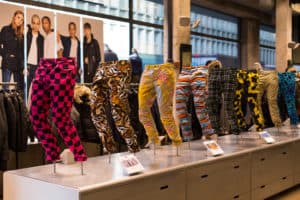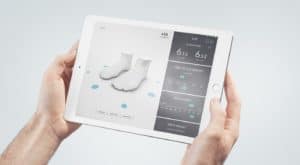The NRF 2018 expo floor was packed with more than 500 vendors sprawling over two floors, plus a tucked away yet equally impressive innovation lab with more vendors displaying their technology.
While Internet Retailer only visited a fraction of the booths, here are some of the highlights:
Rent the Runway and iPads
Rent the Runway Inc. is shifting its focus to its clothing subscription rental service. For $159 a month, consumers can rent up to four items at a time, and exchange as often as they like.
The retailer launched the service in January 2016 and it quickly became popular, flooding the retailer’s five stores, Hampton Catlin, senior director of engineering at Rent the Runway told Internet Retailer at NRF.
Shoppers were going in before work to rent pieces, often waiting in front of the store for it to open, and returning pieces after work the same day, Catlin said. The retailer extended its store hours to accommodate shoppers.
Because all of Rent the Runway’s sales are online—the stores don’t have cash registers—the retailer decided to update its in-store technology with self-serve kiosks (really, iPads on stands) to quickly let a shopper return her rental instead of waiting in a line for an associate to scan it.
The retailer uses Aila Technologies’ software development kit for the iPads. A shopper walks up to a kiosk, scans the clothing item’s unique barcode and leaves the garment. Rent the Runway tracks each piece of clothing, for example how many times it’s been worn, and knows which piece of clothing each consumer has.
This has helped speed the exchange process and soon the retailer will add self-service checkout kiosks as well, Catlin said. Rent the Runway Inc. is No. 229 in the 2017 Internet Retailer Top 1000.
Lolli & Pops and facial recognition
A chocolate shop inside a booth pretty much guarantees me swinging by to check it out. Chocolatier Lolli & Pops had a demo version of its store set up inside of technology manufacturer Intel Corp.’s booth.
Lolli & Pops, which has 50 stores and will grow to 80 in 2018, is launching facial recognition technology in its stores to tie together data from its store shoppers, online shoppers and loyalty program, CEO Sid Gupta told Internet Retailer at NRF.
The opt-in program allows Lolli & Pop’s in-store cameras to recognize a shopper’s face when she enters the store. Once the camera identifies the shopper, the store associate will then have data on what she has bought in store and online and her current loyalty status. Using this the associate can then better serve her with this preference data, Gupta said. He hopes the technology will increase purchase frequency and cart size.
Lolli & Pops opened in 2012 and launched its e-commerce website ahead of the 2016 holiday season. Online sales are less than 5% of its business, but growing, he said. Stores are an important part of Lolli & Pops e-commerce strategy for distribution and being able to offer same-day shipping from stores, Gupta said.
G Star and RFID tags
 Inventory accuracy isn’t the sexiest topic but it’s key to a successful buy online, pick up in store or ship from store strategy.
Inventory accuracy isn’t the sexiest topic but it’s key to a successful buy online, pick up in store or ship from store strategy.
Jeans retailer G-Star Raw rolled out RFID tags in April 2017 to help improve its store inventory accuracy, IT project manager Patriek den Haan said.
Each pair of jeans has an RFID tag within the normal store tag. The retailer has a sensor box mounted on the wall that uses Intel technology to sense the number of products. The store uses RFID vendor Riot Insight LLC software to interpret the data and understand the number of products both on the sales floor and in the back room.
The technology allows G-Star to know when one of its 300 stores can fulfill an online order, or if its one European warehouse or one U.S. warehouse should fulfill the order, den Haan said. The tags also prevent the retailer from having to cancel orders because it doesn’t have enough inventory in stock, delay orders because a faraway warehouse has to fulfill the order or have to dip into the store’s “safety inventory,” he said. E-commerce is roughly 20% of G-Star’s sales, den Haan said.
Den Haan is extremely pleased with the results, as the technology has improved store accuracy to 98%, he said. Previously, its flagship store was at 75% accuracy, so this is a notable improvement. Although, some stores were already at 94% accuracy so in those it is only a marginal improvement, he said.
The technology is in 20 stores and the retailer is planning to roll it out to more, den Haan said.
G-Star has on average 15 of the sensor boxes per store, but that varies depending on the size of the store. For example, its flagship store has 39 boxes, but its next biggest store has 29 boxes, he said.
Visual search and everyone
Online retailers are reaping benefits of visual search technology. In the past few years several large retailers have added this functionality to their mobile app including shoe retailer Zappos (owned by Amazon.com Inc., No. 1), web-only furniture retailer Wayfair Inc. (No. 16), and marketplace giant eBay Inc. (No. 4 in the 2018 Internet Retailer Online Marketplaces ranking).
While some retailers have built this technology in-house, 35 online retailers, including The Home Depot Inc. (No. 8), Urban Outfitters Inc. (No. 40) and Neiman Marcus (No. 41) have used visual search vendor Slyce for it.
The technology allows a shopper to take or upload a picture in a retailer’s app, and the app will surface results that are most visually similar from the retailer’s product inventory. For example, if a shopper sees a shirt she likes, she can take a picture and find a similar-looking one to buy in the Neiman Marcus app. Slyce gets an updated product feed every night to ensure the inventory stays current.
This technology can be particularly useful when shoppers don’t know how to describe a product in words, such as a piece of hardware. A Slyce executive said the number of visual searches in Home Depot’s app dwarf’s all of Slyce’s other clients.
The technology will be displayed next at a Tommy Hilfiger fashion show during Milan Fashion Week on Feb. 25. A consumer will be able to snap a picture of an outfit going down the runway, and then find those items to buy in its Tommyland app.
New Balance and a 3-D foot scanner
 In an effort to make online orders of shoes fit more accurately, Volumental developed a 3-D scanner for shoe retailers. The $6,500 hardware and $3,500 software scans a consumer’s feet to get an accurate measurement of each foot’s length, arch height, ball width and seven other factors, to find the best-fitting shoe from the retailer based on these measurements. The technology also factors in if the consumer prefers a loose or tight-fitting shoe.
In an effort to make online orders of shoes fit more accurately, Volumental developed a 3-D scanner for shoe retailers. The $6,500 hardware and $3,500 software scans a consumer’s feet to get an accurate measurement of each foot’s length, arch height, ball width and seven other factors, to find the best-fitting shoe from the retailer based on these measurements. The technology also factors in if the consumer prefers a loose or tight-fitting shoe.
The shopper can then buy the shoe in the store, or take the information to then buy the shoe online.
The technology is in 1,000 stores globally such as hockey equipment retailer Bauer, and shoe retailers New Balance Athletics Inc. (No. 307), Fleet Feet Sports and Lotta from Stockholm.
According to Volumental, New Balance has had the scanner in a few stores for a year, and those stores have seen a 21.6% increase in sales because of the technology. New Balance declined to comment on sales figures.
This holiday season, the NRF estimates that consumers spent $138.4 billion in nonstore sales, which is 20.0% of its $691.9 billion of total retail sales in November and December, up from 18.7% for 2016 holiday season. (Nonstore sales mainly take place online, but also include mail and telephone orders, door-to-door sales and sales through vending machines.) E-commerce is a growing portion of total retail sales, and retailers benefit when they add digital technology to assist sales in their physical stores.
